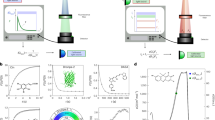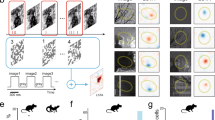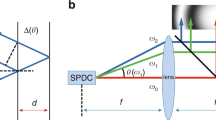Abstract
USING a laser interferometer we can create grating patterns of high optical contrast (interference fringes) directly on the retina1–3. With coarse fringe patterns, the alternating light and dark bars of the pattern can be seen, but the bars of the finest fringes are not subjectively resolved. We report here that when we rapidly modulate the contrast of a fine fringe pattern (keeping overall luminance constant), observers experience flicker, even if the fringes are too finely spaced to be perceived as a grating. For this flicker to be seen, the pattern needs to be resolvable by the photoreceptors themselves, but not necessarily by later stages of visual processing. It can be explained if, in man, signals associated with individual cone receptors do not depend linearly on light intensity, but instead are scaled by a fast sensitivity-regulating or light-adaptation mechanism. Contrast-modulation flicker is not demonstrable in rod vision; rod vision therefore lacks such a local adaptation process.
This is a preview of subscription content, access via your institution
Access options
Subscribe to this journal
Receive 51 print issues and online access
$199.00 per year
only $3.90 per issue
Buy this article
- Purchase on Springer Link
- Instant access to full article PDF
Prices may be subject to local taxes which are calculated during checkout
Similar content being viewed by others
References
Williams, D. R. Vision Res. 25, 195–205 (1985).
MacLeod, D. I. A., Williams, D. R. & Makous, W. Vision Res. 32, 347–363 (1992).
Campbell, F. W. & Green, D. G. J. Physiol. Lond. 414, 89–109 (1965).
Boynton, R. M. & Whitten, D. N. Science 170, 1423–1426 (1970).
Polyak, S. L. The Retina (University of Chicago Press, Chicago, 1941).
Miller, W. H. & Bernard, G. D. Vision Res. 23, 1365–1369 (1983).
Kelly, D. H. J. opt. Soc. Am. 61, 537–546 (1971).
Tranchina, D. & Peskin, C. S. Visual Neurosci. 1, 339–348 (1988).
MacLeod, D. I. A. & He, S. Invest, Opthalmol. Vis. Sci. 33, 1136 (1992).
Schnapf, J., Nunn, B. J., Meister, M. & Baylor, D. A. J. Physiol Lond. 427, 681–713 (1990).
MacLeod, D. I. A., Chen, B. & Crognale, M. Vision Res. 29, 965–978 (1989).
Baylor, D. A., Nunn, B. J. & Schnapf, J. L. J. Physiol., Lond 357, 575–607 (1984).
Burton, G. J. Vision Res. 13, 1211–1225 (1973).
Rushton, W. A. H. Proc. R. Soc. B162, 20–46 (1965).
Author information
Authors and Affiliations
Rights and permissions
About this article
Cite this article
MacLeod, D., He, S. Visible flicker from invisible patterns. Nature 361, 256–258 (1993). https://doi.org/10.1038/361256a0
Received:
Accepted:
Published:
Issue Date:
DOI: https://doi.org/10.1038/361256a0
Comments
By submitting a comment you agree to abide by our Terms and Community Guidelines. If you find something abusive or that does not comply with our terms or guidelines please flag it as inappropriate.



